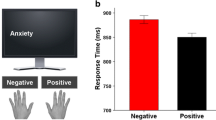Abstract
This study reports the results of one experiment and a replication, aimed at investigating heart rate changes related to a purely intuitive task. In each experiment, 12 subjects were required to guess which of four pictures presented in sequence for about 10 s was the target. Each subject performed 20 trials. In each trial, the target was automatically selected using a pseudorandom algorithm. The heart rate was recorded during the picture presentation. In the first experiment, a statistically significant heart rate increment associated with targets with respect to nontargets was observed. The replication experiment with 12 new subjects confirmed the data obtained in the main experiment. These findings support the hypothesis that heart rate is related not only to conscious but also to unconscious cognitive activity such as that involved in intuitive tasks, giving convergent evidence for the models describing human intuitive cognitive activity as a double, partially independent information processing system.
Similar content being viewed by others
REFERENCES
Cacioppo, J.T., Klein, D.J., Berntson, G.G. and Hatfiled, E., The Psychophysiology of Emotion, Handbook of Emotions, Lewis, M. and Haviland, J.M., Eds., New York: Guilford, 1993, p. 119.
Palomba, D., Angrilli, A., and Mini, A., Visual Evoked Potentials, Heart Rate Responses and Memory to Emotional Stimuli, Int. J. Psychophysiol., 1997, vol. 27, p. 55.
Zajonc, R.B. and Mcintosh, D.N., Emotions Research: Some Promising Questions and Some Questionable Promises, Psychol. Sci., 1992, vol. 3, p. 70.
Graham, F.K. and Clifton, R.K., Heart Rate Change As Component of the Orienting Response, Psychol. Bull., 1966, vol. 65, p. 305.
Hanh, W.W., Attention and Heart Rate: A Critical Appraisal of the Hypothesis of Lacey and Lacey, Psychol. Bull., 1973, vol. 79, p. 59.
Coles, M.G.H. and Duncan-Johnson, C.C., Cardiac Activity and Information Processing: The Effect of Stimulus Significance and Detection an Response Requirement, J. Exp. Psychol. Hum. Perception Performance, 1975, vol. 1, p. 418.
Schwartz, G.E., Cardiac Response to Self-Induced Thoughts, Psychophysiology, 1971, vol. 8, p. 463.
Gellatly, I.R. and Meyer, J.P., The Effects of Goal Difficulty on Physiological Arousal, Cognition, and Task Performance, J. Appl. Psychol., 1992, vol. 77, no.5, p. 694.
Vaughan, F.E., Awakening Intuition, Garden City, New York: Anchor, 1979.
Shirley, D.A. and Langan-Fox, J., Intuition: A Review of the Literature, Psychol. Rec., 1996, vol. 9, p. 553.
Baylor, A.L., A Three-Component Conception of Intuition: Immediacy, Sensing Relationships and Reason, New Ideas Psychol., 1997, vol. 12, no.2, p. 185.
Stanovich, K.E. and West, R.F., Individual Differences in Reasoning: Implication For the Rationality Debate, Behav. Brain Sci., 2000, vol. 23, p. 645.
Lieberman, M.D., Intuition: A Cognitive Neuroscience Approach, Psychol. Bull., 2000, vol. 126, no.1, p. 109.
Bechara, A., Tranel, D., Damasio, H., and Damasio, A.R., Failure to Respond to Anticipated Future Outcomes Following Damage to Prefrontal Cortex, Cerebral Cortex, 1996, vol. 6, no.2, p. 215.
Bechara, A., Damasio, H., Tranel, D., and Damasio, A.R., Deciding Advantageously before Knowing the Advantageous Strategy, Science, 1997, vol. 275, p. 1293.
Blanchard, E.B., Wulfert, E., Freidenberg, B.M., et al., Psychophysiological Assessment of Compulsive Gamblers' Arousal to Gambling Cues: A Pilot Study, Appl. Psychophysiol. Biofeedback, 2000, vol. 25, no.3, p. 155.
Meyer, G., Hauffa, B.P., Schedlowski, M., et al., Casino Gambling Increases Heart Rate and Salivary Cortisol in Regular Gamblers, Biol. Psychiatry, 2000, vol. 48, no.9, p. 948.
Sharpe, L., Tarrier, N., Schotte, D., and Spence, S.H., The Role of Autonomic Arousal in Problem Gambling, Addiction, 1995, vol. 90, p. 1529.
Massaccesi, S., Un sistema modulare portatile per la rilevazione dell'attivita elettrodermica e della frequenza cardiaca (A Portable Modular System for Electrodermic and Heart Rate Acquisition), Giornale Italiano Di Psicologia, 2001, vol. 4, p. 825.
Dunlap, W.P., Cortina, J.M., Valow, J.B., and Burke, M.J., Meta-Analysis of Experimental Data with Matched Groups or Repeated Measures Designs, Psychol. Methods, 1996, vol. 1, no.2, p. 170.
Blair, R.C. and Karniski, W., an Alternative Method for Significance Testing of Waveform Difference Potentials, Psychophysiology, 1993, vol. 30, p. 518.
Peladeau, N. and Lacoutre, Y., SIMSTAT: Bootstrap Computer Simulation and Statistical Program for IBM Personal Computer, Behav. Res. Methods Instruments Computer, 1993, vol. 25, no.3, p. 410.
Author information
Authors and Affiliations
Additional information
__________
From Fiziologiya Cheloveka, Vol. 31, No. 6, 2005, pp. 32–36.
Original English Text Copyright © 2005 by Tressoldi, Martinelli, Massaccesi, Sartori.
This article was submitted by the authors in English.
Rights and permissions
About this article
Cite this article
Tressoldi, P.E., Martinelli, M., Massaccesi, S. et al. Heart Rate Differences between Targets and Nontargets in Intuitive Tasks. Hum Physiol 31, 646–650 (2005). https://doi.org/10.1007/s10747-005-0108-y
Received:
Issue Date:
DOI: https://doi.org/10.1007/s10747-005-0108-y




